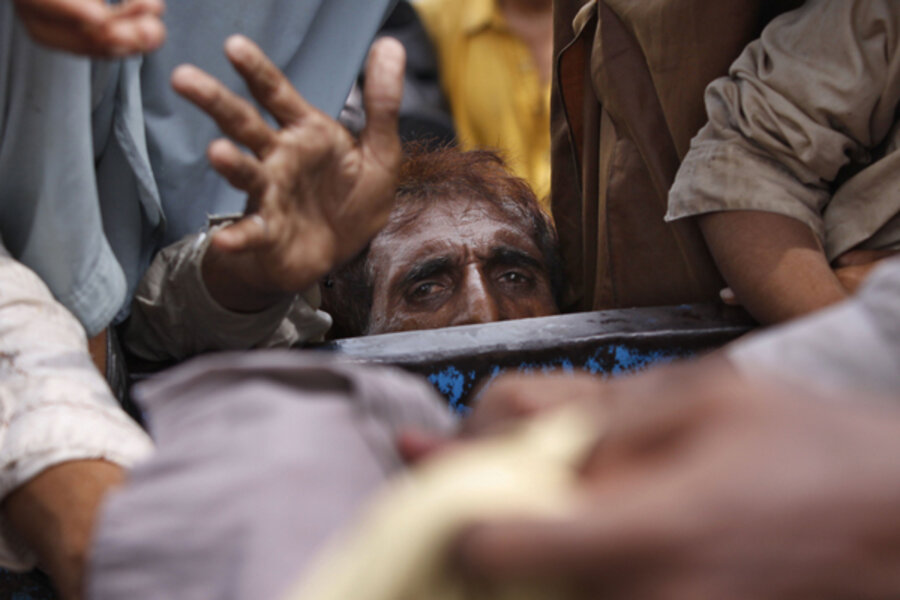Pakistan floods: How new networks of Pakistanis are mobilizing to help
Loading...
| Lahore, Pakistan
Ain-ul-Ghazala, a local Pakistani doctor, says what motivated her to take matters into her own hands came down to what she saw on television. Images of immense misery and destruction brought about by the worst floods in Pakistan in recent memory unfolded before her eyes, and she says she couldn't sit still.
She had noticed hundreds of tents setup on the streets of her hometown, where various groups sought funds and materials. But despite hearing repeated calls for more aid, tales of corruption deterred her from donating to the government or aid organizations, and she didn’t want to give her money to Islamist groups like Jamat-ud-Dawa.
“No one trusts the government anymore, so I wanted to see the situation for myself and do what I could to help,” she explains. As the effects of the disaster wound into a third week, the gynecologist, who works at a private hospital owned by her husband, decided to set off to the flood-afflicted southern Punjab region along with her three adult daughters and one of their friends, also a female medical doctor.
IN PICTURES: Pakistan floods
Over the course of two days, they distributed, tents and food, while the two doctors checked in on some 200 patients in Kot Addu, near Muzaffargarh. “There were a lot of people suffering," she says. On top of the health problems, "some didn’t have anything to wear - they were without any clothes,” she says. “We gave iron and calcium supplements to the pregnant women, and ended up seeing a few male patients, too.”
Such stories are becoming increasingly common as educated Pakistanis are taking matters into their own hands, organizing fund-raising activities and distributing aid direct to victims of the flood.
Civil society and activism in Pakistan
According to Rasul Baksh Raees, head of social sciences at the Lahore University of Management Sciences, the reach and influence of civil society has grown as Pakistan’s middle classes have become more affluent, organized (thanks in no small part to the Internet age), and confident.
In recent years, Pakistan’s civil society has made headlines for its activism. Indeed, students and middle-class professionals joined lawyers in a movement to restore the country’s popular Chief Justice Iftikhar Muhammad Chaudhry, who was removed from office twice in recent years by former military ruler Gen. Pervez Musharraf.
The networks formed during that "lawyers movement" are the ones that Maham Ali, a student at Bahria University in Islamabad, and her friend Samad Khurram, a Harvard graduate who recently returned to Islamabad, turned to help raise funds for victims of the flooding in the country’s northwest.
Ms. Ali says she used Facebook to solicit contributions from relatives, friends, and friends of friends both at home and abroad. She raised some $2,300, transmitted either to her mother’s bank account or via Western Union transfers, to spend on "family packs" (food items, flour, cooking oils, sugar, lentils, and candles) for the victims of the flooding in Swat. Mr. Khurram and half-a-dozen friends, meanwhile, organized a couple of truckloads of meals and traveled to Swat to hand over supplies to the Army for distribution.
The group was stranded for three days by landslides but then traveled to the village of Solgarah in Pakistan’s northwest to setup a Tandoor kitchen that would feed 50 families for 10 days.
“Naturally we don’t have enough donations for everyone,” says Khurram. “So we tried to make sure the same families aren’t getting the same stuff again and again.”
Tapping the Internet and mobile technology
Avoiding duplication of efforts was also a key motivation for Faisal Chohan, an Islamabad-based technology entrepreneur who created a website to keep track of flooding, aid, shelters throughout Pakistan. Aid workers, officials, and residents can use the system via text message or smart phone log on at: http://pakreport.org/
The open-source platform was originally created in Kenya and called Ushahidi, Swahili for "testimony." It maps user reports of events sent via text message, e-mail, the Web and Twitter. Explains Mr. Chohan: “We believe the mobile [phone] is the best way to communicate with people in normal conditions as well as disasters. This was tried and tested in Kenya and Haiti. Why not put all this first line of reporting on mobiles in Pakistan?” With more than 90 million mobile phone users, he says, it has the potential to become the largest deployment of Ushahidi anywhere in the world.
Others still see opportunities for creative methods of fundraising. Zahra Mirza, a young artist in the city of Lahore, says it’s important to keep the public’s interest alive as donor fatigue sets in, even among Pakistanis. Along with a group of friends and upcoming artists known collectively as Sanjh, a Punjabi word meaning “togetherness,” Mirza has organized an art auction at the city’s major Alhamra gallery.
To Dr. Raees, the analyst, such initiatives highlight both the lack of faith Pakistanis place in the civil institutions, but also the strong sense of solidarity that unites Pakistanis of different ethnicities and cultures.
“Generally, foreign experts portray Pakistan as a fragmented, divided, and confrontational society,” he says. In reality, he argues, “there are overlapping layers of social forces: religion, history, and tradition that bind the Pakistani people together. Pakistaniat, Pakistani nationhood, is something very strong but unacknowledged by many analysts.”
IN PICTURES: Pakistan floods





